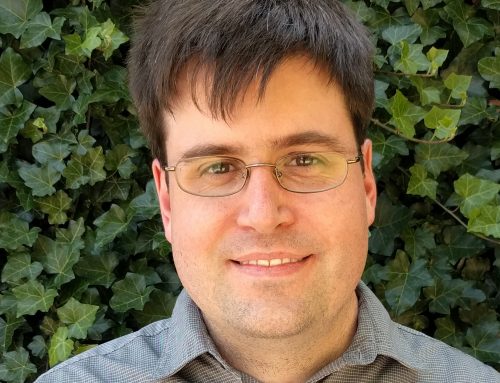In her News & Views article “Dueling with Dualism” (July, 1993), Nancy Scott argued forcefully that Christians and the church have tended historically to divide reality and everyday experience into two realms: the flesh and the spirit. Nancy did an outstanding job of pointing out the error of this kind of approach to understanding and living the Christian life. She explained that the Bible simply does not teach that human existence, albeit fallen, can be divided simplistically, dualized, into “spiritual activities” (praying, reading the Bible, leading a Sunday School class, evangelizing, and so forth) and “fleshly activities” (doing science, philosophy, or those quintessentially awful things: art, music, theater, poetry, literature).
I have been wearied recently by a rather steady stream of questions from the well-meaning Christian community in which most all vocations are justifiable for Christians (especially those which “make money for the Kingdom!”) except art. You see, a calling to involvement in the arts is inherently suspect unless those called compose songs for worship or a Christian concert tour, do art for Christian banners and posters, or write for evangelistic purposes. Perhaps that’s putting it a bit strongly, but that’s the way it is according to most of the artists with whom I’ve talked and counseled.
Honestly, I do understand why many pastors, leaders, and Christian parents are paranoid about art and its social world. After all, is it not true that in the last century art, music, theater, and cinema have been the cultural “carriers” of radical messages and biases against the traditional morality of Christianity and the Gospel message itself? The art world has become a domain for many radicals who take great pleasure in flaunting their disdain for “normal” or traditional society.
While the above is true, I would argue that one of the reasons the arts have gone so quickly and powerfully with the winds of rebellious secularism and anti-Christian sentiment is that the church and well-meaning Christians barricaded themselves into a Christian sub-culture, complete with a “ghetto” mentality. This unbiblical “fortress/ghetto” mentality is part of what Nancy Scott’s article analyzed helpfully for us. In other words, the arts, along with other cultural pursuits, were more or less abandoned by Bible-believing Christians, and the world was more than happy to allow and to encourage that abdication.
So now we find ourselves as Christians at the end of the twentieth century with very little real voice or influence in the arts in our surrounding secular culture. The exceptions are those occasions when our Christian world view and moral frame of reference is violated by outrageously immoral art images or lyrics confronting us and our families in the public arena. And on those occasions what the secularly-biased culture around us hears is our heated complaining. What they should see and hear is brilliant, poignantly crafted art presenting an alternative vision of life to the nihilistic, dark, sadomasochism often portrayed as “art.”
Permit me to switch gears at this point to share with you some encouraging news about the world of art and the Christian community. For, indeed, there are some wonderful things happening with Christian artists in the larger body of Christ.
Recently I attended a four-day conference for artists from all over the U.S. and Canada sponsored by an organization called CIVA, Christians In the Visual Arts. Over ten years ago this organization was formed by Christian artists for the purpose of gathering together for mutual biblical encouragement and fellowship. Their experiences as Christians doing art as a calling have been difficult, not just because doing good art is a demanding craft not susceptible to making a secure living, but also because most of their experiences with the church are less than encouraging. Being a Christian artist, being harshly rejected by the non-Christian art world, and trying to do art with integrity before the Lord is one task. Being a Christian artist and having to defend your life vocation to other Christians who question the worth of your calling and at times your very sincerity as a true believer is a personal trial of another sort. CIVA conferences, occurring every other year, provide a desperately needed occasion where Christian artists can gather to affirm each other spiritually and biblically, and also help each other with shop talk about doing art. From very small beginnings, the CIVA organization has grown to minister to hundreds of artists from all over the U.S and around the world.
Permit me to cite one small example. Addy, a recent graduate from one of this country’s premiere schools for art and design, came to this year’s CIVA conference hoping to find some spiritual encouragement and some people with whom to talk specifically about her future as an artist desiring to follow her Savior in the vocation of art. Confused, hungry for encouragement, lacking in advice about being a Christian in the secularly dominated field of art, Addy finished the conference with a smile on her face. Addy came away from the conference affirmed in her Christian beliefs and hope that just as there are followers of Christ doing scientific research, designing and building homes, teaching mathematics and history and literature, and practicing law, so there are Christians who are seriously following Christ in the pursuit of their artistic vision.
Perhaps at this juncture you would say, “But art is not important.” At least, you think, not as important as becoming a history teacher, a lawyer who can fight for justice in the courts of the land, and certainly not as important as becoming a serious student and teacher of the Bible! I would object, and argue with you about two flaws in your conclusion.
Firstly, such a conclusion ignores the fact that Scripture teaches us that the body of Christ, His church, is made up of many members or parts. All are different, all are important—to use the physical metaphor—for the total functioning and life of the body. We know that God provided artisans and craftsmen for the building and maintenance of His temple for Israel. From this fact alone, we can conclude that it was God’s idea to provide art for His people and that God saw art as a normal, integral part of Israel’s religious and cultural life. In other words, some of God’s people were gifted, called, or “assigned” by Him to serve with their creative abilities in the production of art. Some of it, indeed, was even figurative and abstract!
Secondly, in the hierarchy of human necessities in this fallen world, art is definitely lower on the scale of necessities than appropriating food for physical health and studying to understand the Gospel for one’s own spiritual survival. It can be argued that the task of Bible teachers and evangelists like the Apostle Paul are more vital, from a certain perspective, than the task of making art for our lives and culture. But it is mistaken to conclude from this fact that doing art is not important and legitimate as a calling before God and as a vital contribution to our creational and spiritual existence. Just as it is mistaken to say, using the biblical metaphor of the body, that because “eyes” and “hearts” are really important, therefore everyone who is not an “eye” or a “heart” is expendable. The human body can certainly do without a toe or finger or even another limb or organ if accidents or tragedies present such circumstances. A normal, whole, and healthy human body, however, possesses all the parts God designed and created to be there. And, from a certain perspective, the whole body is “injured” if a small, apparently “unimportant” part of the body is missing or hurting.
To sum up, art is not as important as understanding and spreading the Gospel. But nothing among human endeavors is as important as those things. Art is a legitimate calling for some believers among us. And, common sense informs us that artists themselves will best spread the Gospel among artists! Unfortunately, among the many weaknesses and failures of the church—some of them flowing from its unbiblical material/spiritual dualism—stands the one which calls art “unspiritual” or “worldly” while ignoring the principles of calling and vocation among the members of the body of Christ.
While art is but one among many callings for Christians today, I would go on to argue that the nature of our technological, “image-loaded-and-mediated” society places the arts in the forefront of culture-making power. This fact has great implications for art’s strategic and penetratingly influential role in shaping our vision of what it means to be human in our postmodern society. I believe that our, and especially our children’s, world views and life values are going to be massively influenced by the contemporary world of art and artists. Let me explain briefly.
Beginning well over a hundred years ago, the intellectual and artistic elites of our Western culture began to reject the Judeo-Christian world view in favor of either philosophical materialism or a pantheistic-like world view. At the core of these new humanisms lay the belief that man could build a new world through the use of his imaginative, creative mind. First the romanticists, then the modernists, and now those of the postmodern mind believe that millennial or utopian hopes for a better world can become realities through the unlocking of man’s intellectual and imaginative powers. What was once a biblical motif of millennial hope—a new heaven and earth, and mankind’s salvation itself—has been borrowed, transformed, and reinterpreted in the mind of late twentieth-century man as realities he can create through the unshackling and creative opening of his own mind and imagination. Postmodern man can transform himself, make a just world, if only he will believe strongly enough in his imaginative visions and thereby break the chains of outmoded beliefs, ideologies, and religio-moral myths that have locked him away from the apotheosis he is capable of manifesting.
Since the romantic period (roughly 1770 to 1840), leading thinkers, theoreticians, cultural leaders of various stripes, and particularly those in the artistic community—composers, poets, writers, architects, and visual artists—have believed that through the imaginative visions released especially through the arts, man can rise above his lower, selfish proclivities and create a new world. In particular, the German and English romantic idealists believed that art provides that special occasion when the fullest and most liberated, creative, and intellectual powers of man are released to create new and brilliant worlds for humanity.
Leaping ahead to our day, the postmodern mind is similarly optimistic about creating new worlds through imaginative power. Kirk Varnadoe, director of the department of painting and sculpture at the Museum of Modern Art in New York, made the following statements in his commencement address last year to Stanford graduates:
[The] reassuring distinction between what’s true and what’s merely interpretive—between, say, particle physics and poetry—turns out to be damned near impossible to establish with any finality. Even within science itself, data and dogma, truth and conjecture, have been shown to be so tied together there’s no final way to separate them. And the attempt to transfer science’s ideals of mastery and the predictability to other parts of human life seems more and more to be a misuse of our intellectual energy. We are going to dance to the tunes we make for ourselves, regardless of how the atoms move.
I’m trying to suggest that you are entering a changed world, where the relationship between life and art is going to be more problematic and more important. As the “machine age,” the century of hardware, draws to a close, it’s the software—the contingent conditioning, from language on up—that dominates our notion of what defines human activity. The ways people represent the world to themselves—what they like, their styles of seeing, more than what their genes or jobs are—have become the key factors in our reckoning of social identities.
This is in part what philosopher Richard Rorty means when he argues that the twin models of science and philosophy that shaped our aspirations for so long are now being displaced by the twin models of politics and art: pursuing permanent truth seems less critical than learning to negotiate with irreducible pluralism; and the imagination, as the source of the other, alternative worlds, seems closer to the center of the mind’s most important, most determining work.
This rather long quote is important because it characterizes where contemporary humanism is casting its hopeful gaze. For the postmodern humanist, there is no truth except that which each of us creates imaginatively for our own life world. Plural life worlds, values, and spiritual/moral frameworks are the realities we now accept as cultural givens. Art and the human imagination, it is hoped and believed, will provide the primary means for opening ourselves up to these new facts about the world in which we must live.
Without being able to explain further in this brief article, I believe the trend is set. The arts—operating in combination with technological innovation and empowered by political agendas, will increasingly shape the mind and soul of our culture. Imagination; virtual reality; the flashing, bombastic, iconoclastic, and artful images of MTV; Rolling Stone magazine; and mind-boggling cinematic and theatrical productions; all pouring relentlessly from the artful, soulish world view of artists of all kinds—have already begun to make their culture-altering mark on our generation.
Does the church need to reach out to artists and the world of art? I think so. The church can do a better job of encouraging and discipling its visual artists, art historians, critics, classical and jazz musicians, actors, playwrights, and poets. Will the church be able to understand how artists think and feel, and then speak to them, if required, in their own artistic language forms? Only time will tell. I do hope and pray so.





